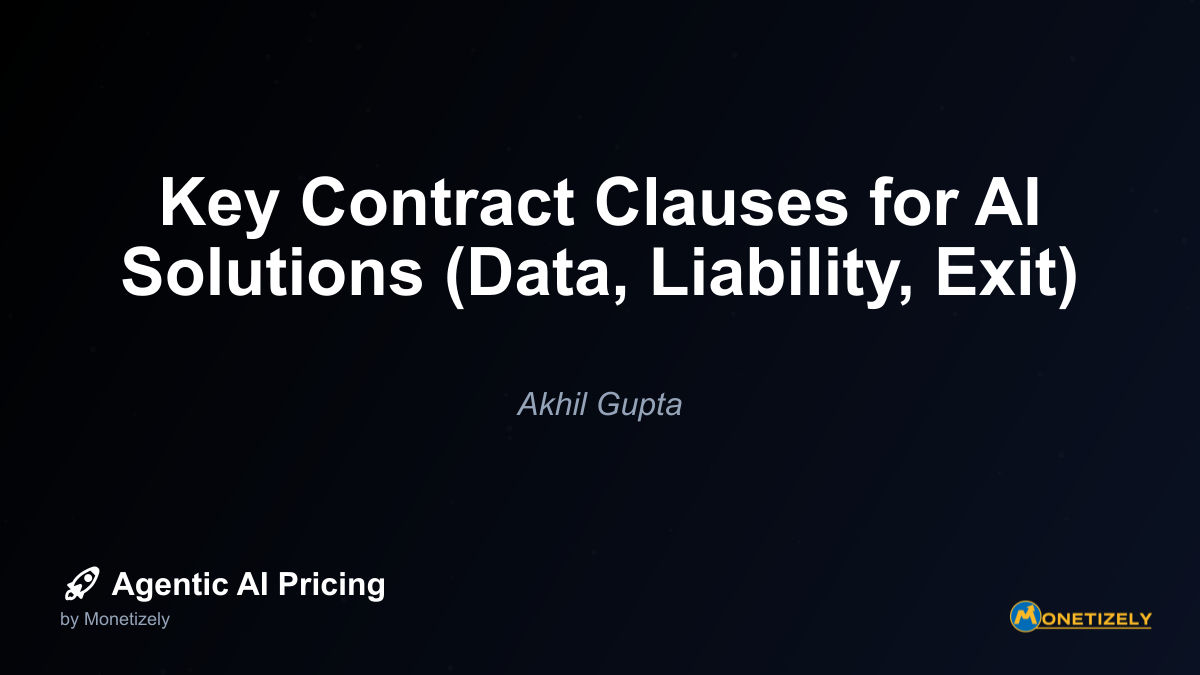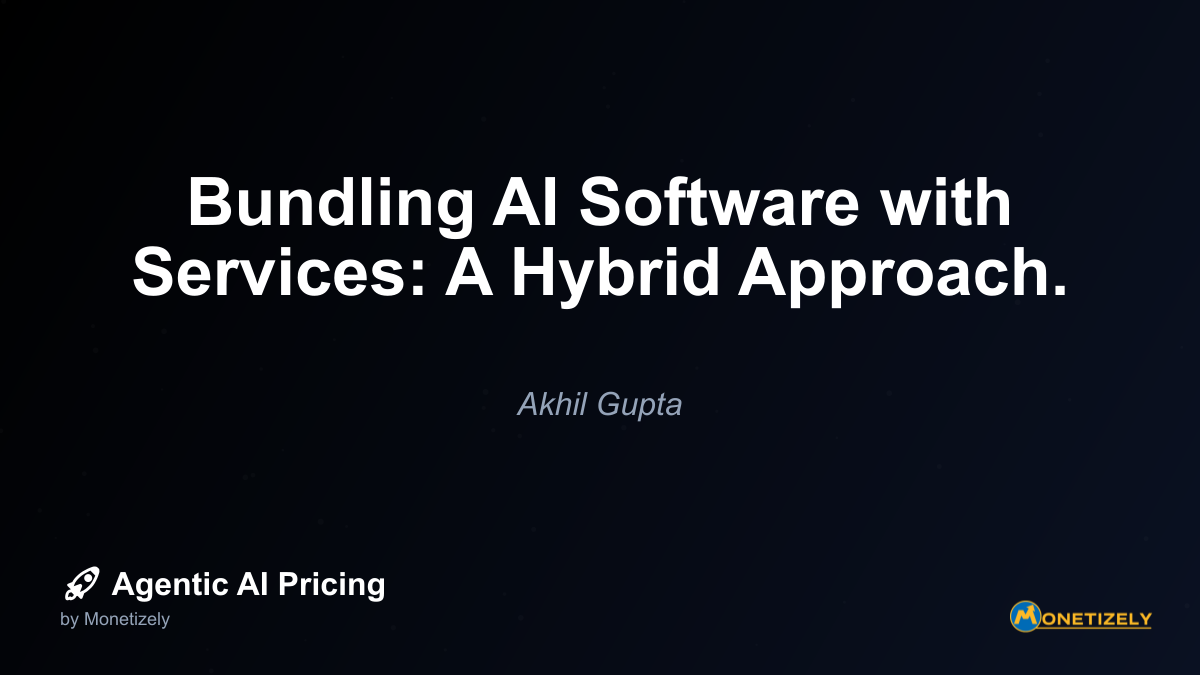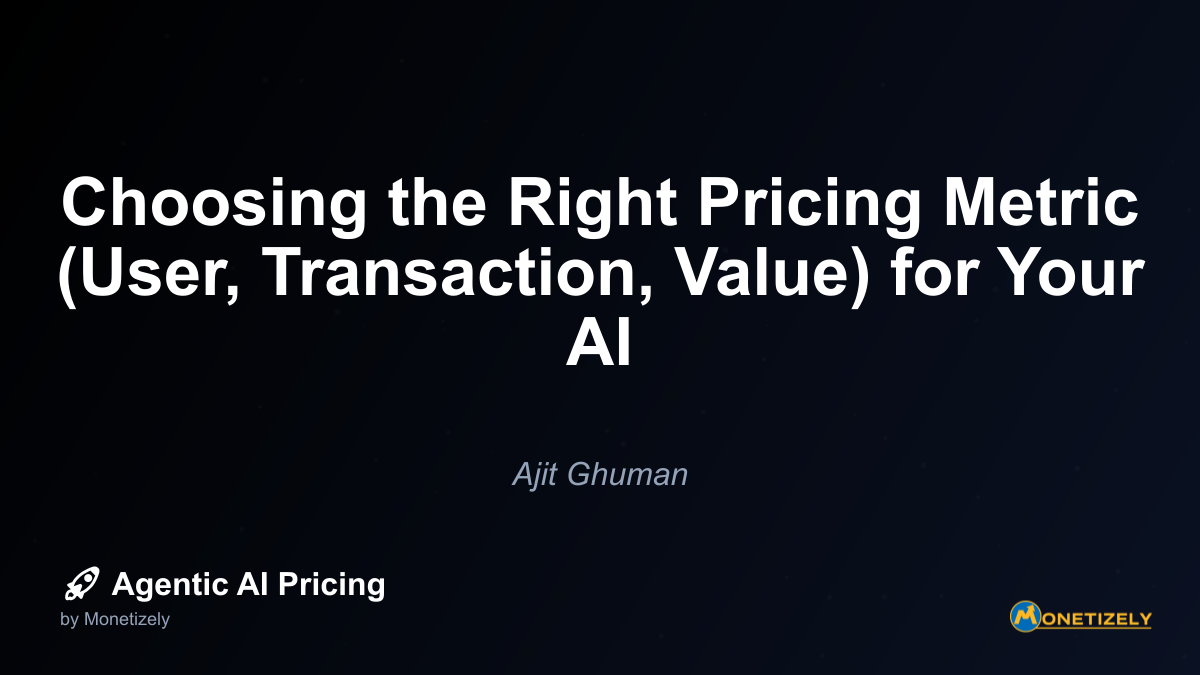· Akhil Gupta · Strategy & Planning · 8 min read
Key Contract Clauses for AI Solutions (Data, Liability, Exit)
AI and SaaS Pricing Masterclass
Learn the art of strategic pricing directly from industry experts. Our comprehensive course provides frameworks and methodologies for optimizing your pricing strategy in the evolving AI landscape. Earn a professional certification that can be imported directly to your LinkedIn profile.

The intersection of artificial intelligence and legal contracts creates a unique landscape where traditional contract clauses must be reimagined. In this article, we’ll explore the essential contract clauses for AI solutions with a particular focus on data usage rights, liability limitations, and termination provisions—all of which directly impact pricing strategies and risk allocation.
Data Usage Rights: The Foundation of AI Value Exchange
Data sits at the heart of every AI solution. The rights surrounding data usage represent perhaps the most critical contractual consideration in AI service agreements. These clauses define who can use what data, how they can use it, and what happens to that data throughout the relationship.
Ownership vs. License Rights
A fundamental distinction in AI contracts is between data ownership and usage rights. While clients typically maintain ownership of their proprietary data, AI providers need certain rights to use that data for specific purposes:
- Training Rights: Can the AI provider use client data to train its models?
- Improvement Rights: Can client data be used to improve the overall AI system?
- Cross-Client Learning: Can insights from one client’s data benefit other clients?
Each of these rights carries significant pricing implications. An AI provider with robust cross-client learning capabilities can offer more competitive pricing because the value of each client’s data extends beyond a single implementation. Conversely, clients who restrict data usage may face premium pricing to offset the provider’s limited ability to leverage data assets across their business.
Data Classification and Handling Requirements
Effective AI contracts establish clear data classification systems that determine handling requirements:
- Public Data: Generally unrestricted usage with minimal contractual limitations
- Confidential Data: Limited usage with specific security requirements
- Regulated Data: Highly restricted usage with strict compliance mandates
- Personal Data: Subject to privacy regulations with explicit consent requirements
The classification directly impacts pricing, as higher security and compliance requirements increase operational costs for AI providers. A contract that requires all data to be treated as regulated, even when unnecessary, may result in pricing inefficiencies that don’t align with actual risk profiles.
Data Retention and Deletion
AI contracts must clearly specify:
- How long data can be retained after processing
- What happens to derived insights and models
- Verification mechanisms for data deletion
- Exceptions for regulatory compliance or security purposes
These provisions influence pricing models by defining the provider’s ongoing obligations and potential future value extraction capabilities. Shorter retention periods may increase costs as providers lose the ability to amortize data value across longer timeframes.
Liability Limitations: Balancing Risk and Reward
AI systems make decisions and predictions that can have significant real-world consequences. How liability is allocated for these outcomes fundamentally shapes the risk-reward balance in AI pricing.
Standard Liability Caps and Exclusions
Most AI contracts include liability limitations similar to traditional software agreements:
- Direct Damages Cap: Typically limited to fees paid over a specific period
- Exclusion of Consequential Damages: Protecting against unpredictable downstream impacts
- Carve-Outs: Exceptions for intellectual property infringement, gross negligence, etc.
However, the unique nature of AI requires additional considerations:
AI-Specific Liability Provisions
The autonomous and learning nature of AI creates novel liability scenarios that should be addressed:
- Algorithm Accuracy Warranties: What performance levels are guaranteed?
- Decision Boundary Clarity: Which decisions remain human responsibility vs. AI?
- Explainability Requirements: Must the AI provider explain how decisions were reached?
- Continuous Monitoring Obligations: Who’s responsible for identifying problematic patterns?
These AI-specific provisions directly influence pricing strategies. Higher performance guarantees, greater explainability, and more robust monitoring requirements all increase provider costs and, consequently, solution pricing.
Risk Allocation Through Indemnification
Indemnification clauses in AI contracts serve as risk transfer mechanisms:
- IP Indemnification: Protection against claims the AI infringes third-party rights
- Data Protection Indemnification: Coverage for data breaches or privacy violations
- Output Indemnification: Protection related to AI-generated content or decisions
The scope of indemnification directly impacts pricing, as providers must factor potential legal exposure into their cost structures. Broader indemnification typically correlates with premium pricing to offset increased risk.
Liability Insurance Requirements
AI contracts increasingly include specific insurance requirements:
- Technology E&O Coverage: For errors in AI system design or implementation
- Cyber Liability Insurance: For data breaches or security incidents
- Professional Liability Coverage: For service delivery failures
Insurance requirements represent a direct cost that influences pricing models. Higher coverage limits increase provider expenses that must be recouped through pricing strategies.
Termination and Exit Provisions: Planning for the End
While often overlooked in initial negotiations, termination clauses significantly impact the total cost of ownership for AI solutions and the long-term value proposition.
Termination Triggers and Notice Periods
AI contracts should clearly define:
- For-Cause Termination: What constitutes material breach?
- Performance-Based Termination: What performance failures justify termination?
- Convenience Termination: Can either party exit without cause?
- Notice Periods: How much advance warning is required?
The flexibility of termination provisions directly influences pricing models. Contracts with easy exit provisions typically command premium pricing to offset the provider’s increased uncertainty, while longer commitments may justify discounted rates.
Data Portability and Transition Assistance
The most critical exit provisions for AI solutions involve data portability and transition support:
- Data Export Formats: What formats will data be returned in?
- Model Portability: Can client-specific models be transferred?
- Knowledge Transfer: How will insights be documented?
- Transition Period Support: What assistance will be provided during migration?
These provisions have substantial pricing implications. Robust data portability and transition assistance increase provider costs but reduce client switching costs. The balance between these factors directly influences both initial pricing and renewal leverage.
Post-Termination Rights and Obligations
AI contracts must address ongoing rights and obligations after termination:
- Surviving Confidentiality Obligations: How long must data remain protected?
- Continued Limited Access: What systems remain available during transition?
- Model Deletion Requirements: Must client-specific models be destroyed?
- Post-Termination Restrictions: What competitive limitations apply?
These provisions impact pricing by defining the provider’s post-relationship obligations and opportunity costs. More restrictive post-termination obligations typically correlate with higher pricing to compensate for these limitations.
The Pricing Implications of Contract Clauses
The contract clauses outlined above don’t exist in isolation from pricing considerations—they fundamentally shape the value exchange between AI providers and clients. Understanding these connections helps both parties negotiate more effective agreements.
How Contract Terms Affect Pricing Models
Different pricing models interact uniquely with contractual provisions:
- Subscription Pricing: Heavily influenced by termination flexibility and long-term commitments
- Usage-Based Pricing: Directly impacted by data rights and usage restrictions
- Outcome-Based Pricing: Shaped by performance guarantees and liability allocations
- Hybrid Models: Designed to balance risk across various contractual dimensions
The alignment between contract terms and pricing models determines whether the agreement creates sustainable value for both parties or sets up future conflicts.
Risk Premium Calculation
AI providers implicitly or explicitly calculate risk premiums based on contractual terms:
- Baseline Pricing: Standard offering with balanced terms
- Risk Adjustments: Premiums for client-favorable provisions
- Discount Opportunities: Reductions for provider-favorable terms
Understanding this calculation allows clients to make informed decisions about which contractual protections justify premium pricing and which can be negotiated without significant value impact.
Contract Term Length and Pricing Leverage
The interplay between contract duration and pricing creates important dynamics:
- Short-Term Agreements: Higher rates but greater flexibility
- Long-Term Commitments: Lower rates but increased lock-in
- Auto-Renewal Provisions: Convenience versus potential price escalation
- Price Protection Clauses: Limiting increases during renewal periods
These temporal aspects of contracts directly influence the lifetime value calculation for both providers and clients.
Negotiation Strategies for AI Contract Clauses
Effective negotiation of AI contract clauses requires understanding both legal protections and pricing implications. Here are strategies for approaching these interconnected considerations:
Prioritizing Clauses Based on Business Impact
Not all contract clauses carry equal importance. Organizations should:
- Identify mission-critical data protection requirements
- Quantify potential liability scenarios and their business impact
- Assess the strategic value of exit flexibility
- Prioritize negotiations accordingly
This prioritization allows for more effective tradeoffs between contractual protections and pricing considerations.
Leveraging Market Standards and Benchmarks
The AI contracting landscape continues to evolve, but certain standards are emerging:
- Industry-specific data protection expectations
- Liability caps as percentages of contract value
- Standard transition assistance requirements
- Typical notice periods for different termination scenarios
Understanding these benchmarks provides negotiation leverage and helps avoid unnecessary premiums for standard protections.
Aligning Contract Terms with Value Realization
The most effective AI contracts align terms with the value realization timeline:
- Initial terms focused on implementation success
- Mid-term provisions centered on performance optimization
- Later-term clauses addressing vendor diversification and exit planning
This temporal alignment ensures contractual protections match the evolving relationship between provider and client.
Future Trends in AI Contract Clauses
As AI technology and regulation continue to evolve, we can anticipate several emerging trends in contractual approaches:
Regulatory-Driven Contract Evolution
New AI regulations will directly impact contract requirements:
- EU AI Act compliance provisions
- Algorithmic accountability documentation
- Mandatory human oversight for high-risk applications
- Cross-border data transfer mechanisms
These regulatory requirements will create new standard clauses and corresponding pricing adjustments.
Ethical AI Contractual Frameworks
Beyond legal requirements, ethical AI considerations are entering contracts:
- Fairness and bias monitoring commitments
- Transparency and explainability obligations
- Human-in-the-loop intervention thresholds
- Ethical use limitations and monitoring
These provisions reflect growing awareness of AI ethics but create implementation challenges that impact pricing.
Dynamic and Adaptive Contracts
The static nature of traditional contracts struggles to accommodate rapidly evolving AI capabilities:
- Performance metrics that adjust as capabilities mature
- Data rights that evolve with regulatory changes
- Liability allocations that shift with risk profiles
- Pricing models that adapt to value realization
These more dynamic contractual frameworks require sophisticated governance mechanisms but offer more sustainable value exchange.
Conclusion: The Contractual Foundation of AI Value
The contract clauses governing data usage, liability, and termination rights form the essential foundation of the AI value exchange. Far from being mere legal technicalities, these provisions directly shape pricing structures, risk allocation, and long-term relationship viability.
Organizations implementing AI solutions should approach contract negotiations with a clear understanding of how legal protections and pricing considerations interrelate. The most successful agreements achieve balance—providing necessary protections while enabling sustainable economics for both parties.
As AI capabilities continue to advance, particularly in agentic systems with greater autonomy, the contractual frameworks supporting these relationships will require ongoing evolution. Organizations that develop sophisticated approaches to AI contracting will gain competitive advantage through better risk management and more efficient pricing structures.
By focusing on the key contract clauses outlined in this article, both AI providers and clients can create agreements that protect their interests while enabling the transformative potential of artificial intelligence.
Co-Founder & COO
Akhil is an Engineering leader with over 16+ years of experience in building, managing and scaling web-scale, high throughput enterprise applications and teams. He has worked with and led technology teams at FabAlley, BuildSupply and Healthians. He is a graduate from Delhi College of Engineering and UC Berkeley certified CTO.
Pricing Strategy Audit
Let our experts analyze your current pricing strategy and identify opportunities for improvement. Our data-driven assessment will help you unlock untapped revenue potential and optimize your AI pricing approach.




